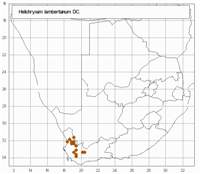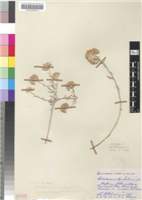Origin of name:
lambertianus /-a/-um = after Aylmer Bourke Lambert (1861-1842), English botanist
Diagnostic characters:
Medium to large headsGrey-white woolly bractsCompact inflorescences
Description:
Shrubby from a stout woody caudex, up to 600 mm tall, branches long, slender, closely white-felted, young ones leafy. Leaves mostly 12-20 x 2-3 mm, diminishing upwards, linear-lanceolate to lanceolate, apex acute, mucronate, base subauriculate, sessile, both surfaces white-felted, minutely glandular. Heads homogamous, turbinate, 5 x 5 mm, few to many crowded in terminal corymbose panicles. Involucral bracts in 4 series, graded, imbricate, outer lanceolate, inner oblong, obtuse, apiculate, about equaling the flowers, not radiating, all greyish-white woolly dorsally, only the extreme tip glabrous. Receptacle smooth. Flowers 19-34, yellow. Achenes not seen, ovaries with duplex hairs. Pappus bristles many, scabrid, tips subplumose or barbellate, bases nude, not cohering.
Flowering between October and January.
Distribution:
Grows on dry stony slopes, among rocks, or in the crevices of rocky cliffs or large boulders'. Recorded from the Gifberg (Vanrhynsdorp distr.) south through the Cedarberg and Koude Bokkeveld to the mountains about Ceres, Worcester, Hex River, Touws River, Montagu and Villiersdorp, then a possible disjunction to Georgida in Uniondale division.
Fynbos Biomes.
Notes:
Easily recognized by its peculiar involucral bracts.
Taxonomy:
Literature:
Helichrysum lambertianum DC., Prodr. 6: 190 (1838); Harv. in F.C. 3: 231 (1865); Moeser in Bot. Jb. 44: 291 (1910).
Type:
Lectotype: Cape, Clanwilliam, Olifants River and Villa Brakfontein, Ecklon 2680 (G-DC).
Synonym(s):
Gnaphalium lambertianum (DC.) Sch. Bip. in Bot. Ztg 3: 171 (1845).
Vouchers:
Acocks 15200 (PRE); Bolus 1051 (BOL; K; SAM); Compton 16751 (NBG); Esterhuysen 22019 (BOL; K; PRE).


